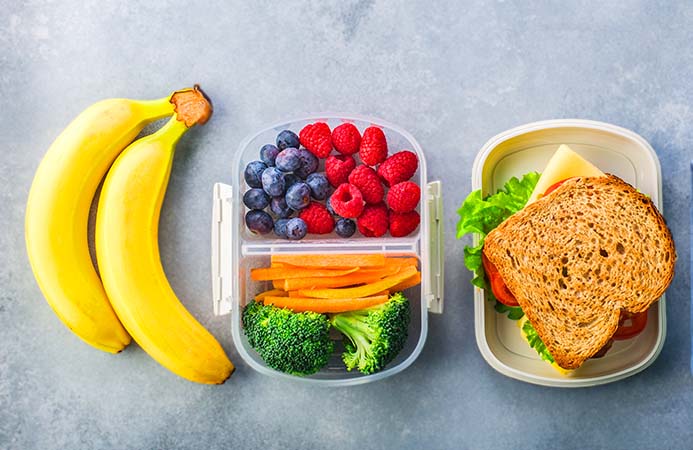By Stefanie Jackson – Accomack school board members were given food for thought when Supervisor of Food Services Brandyn Berkholder and consultant Lori Beckwith updated them on the school food service program, which has continued to serve students even through the COVID-19 pandemic.
The U.S. Congress authorizes the National School Lunch Program every five years, which regulates both the nutritional and financial aspects of school lunch programs. However, the program was last authorized in 2010, so the regulations haven’t changed since then, Beckwith noted.
The nutritional requirements vary among three student groups: grades K to 5, 6 to 8, and 9 to 12. For example, older students need larger portions and more calories.
There are five food groups: meat and meat alternates, grains, vegetables, fruit, and milk.
Meat alternates include cheese, eggs, nuts, peanut butter, beans, peas, yogurt, and tofu.
Fruit can be fresh, frozen, canned, or dried. Fruit juice can be served if it does not exceed half of the daily requirement. For example, a high school student must be offered a cup of fruit per day, so no more than a half-cup of juice may be given.
There are five subgroups of vegetables: dark green, red and orange, beans and peas, starchy vegetables, and other. Vegetables from all subgroups must be offered every week.
Milk is a required menu item, but only skim or 1% may be served, not 2% or whole milk. Flavored milks must be nonfat. Lactose-free milk is provided to students who can’t drink regular milk.
Beckwith noted there has been a push to bring back whole milk, and it may reappear on school menus in a few years.
Breakfasts must have three components: grains, fruit, and milk. There is no meat requirement at breakfast, but meat may be included in the meal if the grain requirement has been met.
Berkholder noted that Accomack schools continue participation in the Community Eligibility Provision, a program of the U.S. Department of Agriculture or USDA that provides free school meals to all students regardless of their household income.
Elementary school students eat breakfast in their classrooms, and middle and high school students get Grab & Go breakfasts, which have “really caught on,” Berkholder said.
Due to COVID-19, there have been no traditional school lunch lines this year; instead of choosing what goes on their lunch trays, students get lunches prepackaged in three-compartment, styrofoam to-go boxes.
There also are no sales of snacks or “a la carte” menu items. The overall “dining experience” for students has declined, but Berkholder expects a return to traditional school meal service in the fall.
The school food service department must undergo an annual Federal Program Administrative Review or FPAR, and the Virginia Department of Education, Office of School Nutrition Programs, publishes the results.
Accomack’s review went “exceptionally well” and it passed in every category.
“The reviewers were impressed with the variety of healthy meals and options that the students were offered on a daily basis,” particularly the “wide variety of fruits and vegetables,” Berkholder said.
They also complimented the food service staff members’ efficiency and ability to work under COVID-19 protocols, Berkholder said.
Fruits offered this year have included cantaloupe, mango, kiwi, apples, and grapes, and one vendor prepackaged the fruit in the half-cup servings required by federal regulations.
“You name it, I think we’ve had it this year,” Berkholder said. “I can’t say the kids eat it. You’d be amazed, the things that go in the garbage can compared to the things that they eat.”
“If we could have french fries and pizza every day, I think you would see less waste, but we’ve at least offered (healthy foods) to them, and I think they’ve taken well to that.”
More than 590,000 meals were served last school year. Nearly 615,000 meals have been served so far this school year. Total meals served should reach 1 million by the end of the school year, Berkholder said.
Challenges the school food service department has faced this year include food shortages and delayed deliveries. Menu changes are approved by Berkholder.
School delays and closures due to inclement weather also affect the menu. Frozen foods that have been thawed must be used within two to three days, so sometimes a meal that students missed due to a school closure will be cooked and served the next day, Berkholder noted.
He suggested that more consistent communication by the food service department through social media such as Facebook and Twitter could help address student and parent concerns about last-minute menu changes.
Meals that draw the highest student participation in school lunch include spaghetti and meatballs, roast chicken, tacos, lunchables, General Tso’s chicken bowls, and nachos grande with queso and pulled pork.
School board vice chair Gary Reese praised Berkholder and Beckwith for their work.
“I know it’s been tough, the last couple years … and it will be nice, and I’m just waiting for the day that (students) can get choices, because I know a lot of food is being thrown away because you have to offer it to everyone.”
He looked forward to getting “more traditional-type things on the menu that they can have choices for, because I know a lot of parents are probably familiar with some of the lunches that they got when they went to school,” and their children “liked to get that, too.”
Beckwith has worked in school food service for 32 years and Accomack has one of the highest breakfast participation rates she has ever seen. “It says a lot for the Grab & Go and the breakfast in the classroom,” she said.



